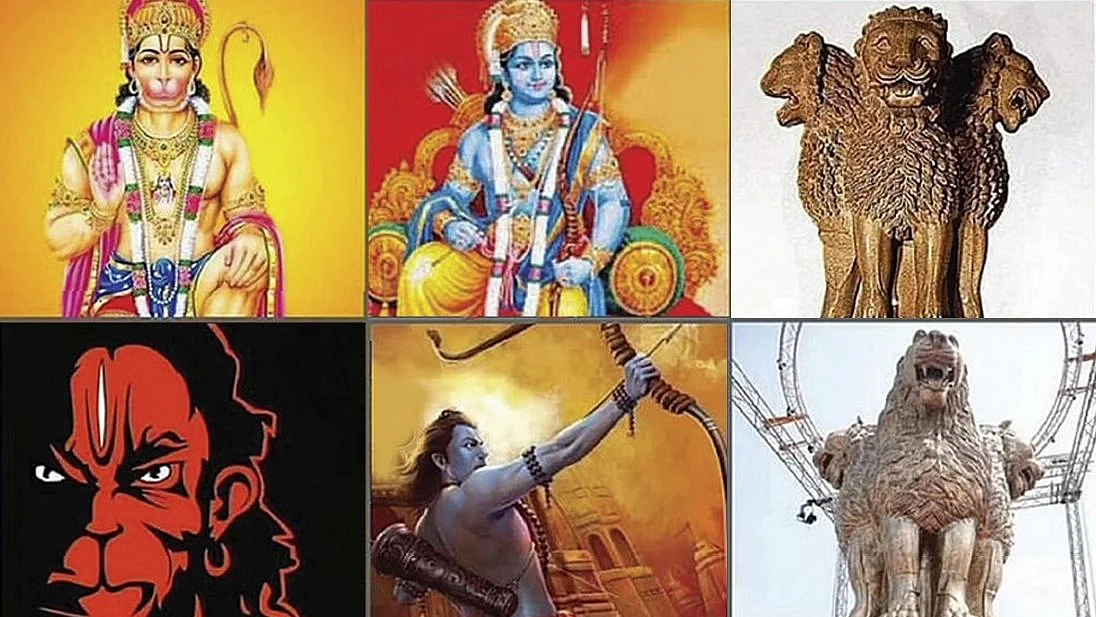Baring fangs in 'New India': Is it distortion by design?
What explains the militant reimagining of the national emblem?

The snarling lion installed on the roof of the new Parliament building this week caused both outrage and consternation. To completely change the character and nature of the lions on Ashoka’s pillar at Sarnath is nothing but a brazen insult to India’s national symbol, felt many. A replica of the national emblem must exactly be the same and the law does not allow liberties with it, they pointed out.
While allegations of deviation from the original were dismissed lightly by progovernment voices (It’s a lion, not a cat. It is supposed to roar, not purr), sculptor Sunil Deore acknowledged there could be minor deviations because of the metal used—bronze in place of stone, and its height (6.5 metre) and its weight (9,500 kg without the base).
Union Minister Hardeep Puri however weighed in to say that the lions looked like snarling because of the acute angle from which viewers below looked at it. This was quickly contested by people pointing out that the Lion Capital of the Ashokan Pillar was also at the top of the pillar and people looked at it from below. Historian Rajmohan Gandhi wryly asked in a column how many people would look at the lion from above!
A Supreme Court Advocate quipped, “Old India: strong, confident and hence endearing. New India: angry, insecure and hence vengeful.” Trinamool Congress MP Jawhar Sircar argued, “State power harps on strength but the national emblem represents restrained strength and peace, not aggression.”
While there was consternation at turning the serene and regal lions on the Ashokan pillar into snarling beasts, some people actually defended it and felt that ‘India has been peaceful for too long’. The new installation depicted the ‘New India’ which is ready to fight at both home and abroad. Several commentators felt the distortion has been deliberate as over the years the transformation of icons have shown. Lord Ram, known and depicted for long as a handsome, fair king known for both his bravery and chivalry, has been turned into an angry warrior. His follower Hanuman, worshipped as reverentially, was once an endearing character who stood for loyalty and chivalry. But he too has been turned into a fierce, unsmiling sticker on cars.

Others felt the new installation was disproportionate. Lion heads are relatively larger in proportion to the torso but in the new installation the lion heads are smaller, some pointed out. The installation, put together by a hundred artisans and craftsmen over six months, was undeniably rushed and put up in a hurry. Perhaps more accomplished sculptors could have been commissioned.
There were other issues that raised eyebrows. The by-now familiar spectacle of the prime minister taking part in a Hindu ritual on the roof came as no surprise. But the question whether the rituals were appropriate or even necessary remained unaddressed.
Even more problematic was the timing and the conspicuous absence of the President of India, who is the Head of State. People wondered why the President, Ram Nath Kovind, was not invited. Surely, that he is a Dalit could have nothing to do with it?
Indeed, only four people seemed to be present on the occasion. Besides the PM, Lok Sabha Speaker Om Birla, Deputy Chairman of Rajya Sabha Harivansh, and Urban Development minister Hardeep Puri were present on the occasion. Why was the Vice President also missing?
With a new President and Vice President due to take over in a matter of weeks, why indeed couldn’t the government wait was another nagging doubt that surfaced. Indeed, the timing of the installation on July 11, barely a week before Parliament begins its monsoon session on July 18, was yet another piece of the jigsaw puzzle. What was the hurry?
As has been pointed out, the Lion Capital of Ashoka at Sarnath marked the spot where Buddha first shared his teachings with his five disciples. With such obvious links to Buddhism, why was no Buddhist monk there? Surely the Indian state can emulate Army’s tradition of having priests from all important religions at all important functions?
Emperor Ashoka erected a number of sculptures, pillars and stone carvings throughout his kingdom to preach the tenets of Buddhism. The Lion Capital is believed to have been erected around 250 BC. The pillar was unearthed during excavation in the area between December 1904 and April 1905. The pillar was found in three sections but the topmost Lion Capital was found intact.
By adopting this sculpture as the national emblem, the Republic recognised its fidelity to the philosophies of Buddha and the positive changes Ashoka had brought to his kingdom; it also reaffirmed its commitment to upholding peace and tolerance. The lions symbolised equality and justice besides strength, courage and confidence. Besides, they stood for eternal vigilance.
(This was first published in National Herald on Sunday)
Follow us on: Facebook, Twitter, Google News, Instagram
Join our official telegram channel (@nationalherald) and stay updated with the latest headlines
Published: 15 Jul 2022, 10:00 AM
